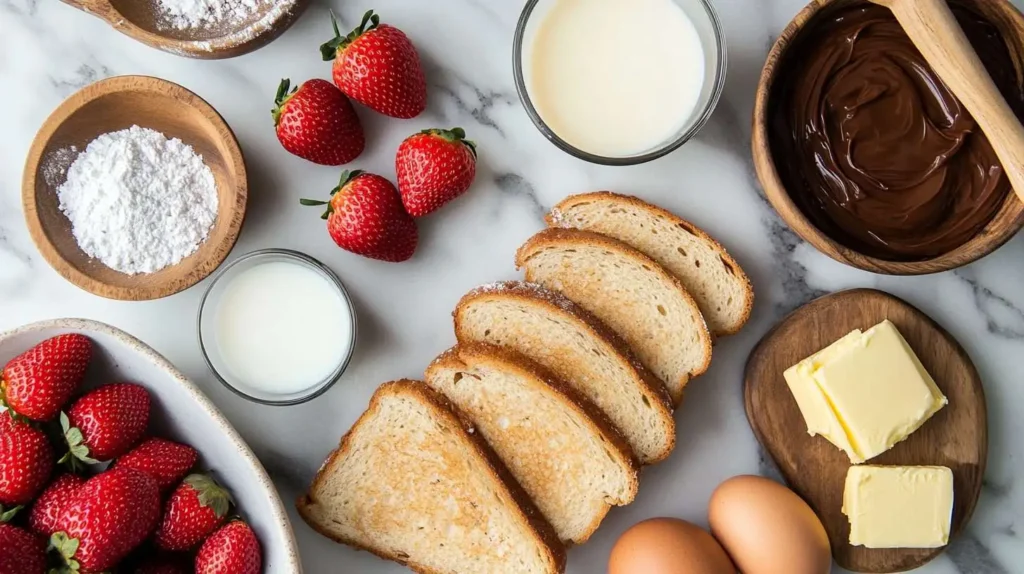Who doesn’t love waking up to a breakfast that feels like a warm hug? If you’re tired of the same old toast or pancakes, the French toast sandwich might just be your next favorite dish. It’s the ultimate combination of sweet and savory, bringing together crispy, golden-brown bread, creamy fillings, and optional savory add-ons like cheese, bacon, or ham. Whether you’re planning a lazy weekend brunch or just craving something indulgent, this dish has you covered.
The beauty of a French toast sandwich is its versatility. You can keep it simple with classic ingredients or get creative with unique fillings and toppings. Want something sweet? Go for cream cheese and fresh strawberries. Craving savory? Ham and melted cheese make it a hearty breakfast option. It’s no wonder this sandwich has become a favorite worldwide, blending the comforting flavors of French toast with the satisfaction of a stacked sandwich.
Table of contents
Ingredients for a French Toast Sandwich
One of the best things about making a French toast sandwich is how simple and flexible the ingredients are. Whether you’re going for a classic recipe or something a bit more adventurous, gathering your ingredients is the first step to creating this delightful breakfast. Here’s everything you’ll need:

Basic Ingredients
To make the base of a French toast sandwich, you’ll need just a few pantry staples:
- Bread: Thick slices like brioche, challah, or sourdough work best. Their texture and flavor soak up the egg mixture beautifully without falling apart.
- Eggs: The star ingredient for the custardy base. Use large eggs for a rich flavor.
- Milk: Adds creaminess to the egg mixture. Whole milk is ideal, but you can use any milk you prefer.
- Sugar: A small amount (1-2 teaspoons) to lightly sweeten the egg mixture. Optional if you’re going for a fully savory sandwich.
- Butter: For frying the bread to golden perfection. You can also use oil, but butter gives a better flavor.
Add-ons and Fillings
Here’s where the magic happens! Depending on whether you’re craving a sweet or savory sandwich, you can mix and match these add-ons and fillings:
Sweet Fillings:
- Maple Syrup: A classic drizzle to add sweetness.
- Fresh Fruits: Strawberries, bananas, blueberries, or even peaches.
- Nut Spreads: Peanut butter, almond butter, or Nutella for a rich, indulgent touch.
- Cream Cheese: Perfect when paired with fruit or jam.
- Cinnamon and Powdered Sugar: Sprinkle these on top for extra flavor and a finishing touch.
Savory Fillings:
- Cheese: Swiss, cheddar, or mozzarella are popular options.
- Ham or Turkey: Thin slices make for a hearty and protein-packed meal.
- Bacon: Crispy bacon adds crunch and a smoky flavor.
- Avocado: Creamy and healthy—great for savory combinations.
- Egg: Add a fried egg for an extra layer of richness.
Tools You Need
Making a French toast sandwich doesn’t require a fancy kitchen setup, but having the right tools can make the process easier and the results more delicious. Here’s a list of the essentials to get you started:
Essential Tools
- Mixing Bowl: A medium-sized bowl for whisking the egg mixture.
- Whisk or Fork: For blending the eggs, milk, and seasonings into a smooth mixture.
- Skillet or Frying Pan: A nonstick skillet works best to prevent sticking and ensures even cooking. Cast iron is another great option for a crispy finish.
- Spatula: A flat, wide spatula is essential for flipping the bread without tearing it.
- Measuring Cups and Spoons: To measure milk, sugar, and spices accurately.
- Knife and Cutting Board: For slicing fruits, cheese, or other fillings.
How to Make a French Toast Sandwich
Ready to craft the ultimate French toast sandwich? Follow these step-by-step instructions, and you’ll have a golden, delicious breakfast (or brunch) in no time.

Step 1: Preparing the Egg Mixture
The egg mixture is the heart of your French toast sandwich, giving it that signature custardy flavor and texture.
- Crack the Eggs: In a medium-sized mixing bowl, crack 2-3 large eggs.
- Add Milk: Pour in ½ cup of milk for creaminess.
- Season: Add 1-2 teaspoons of sugar (optional for savory sandwiches) and a pinch of salt. For sweet sandwiches, include a dash of cinnamon, nutmeg, and ½ teaspoon of vanilla extract.
- Whisk It Together: Use a whisk or fork to combine until smooth and slightly frothy.
Step 2: Choosing the Bread
The bread you choose plays a big role in the final texture and flavor.
- Pick the Right Bread: Thick slices of brioche, challah, sourdough, or even Texas toast work best. Day-old or slightly stale bread is ideal, as it absorbs the egg mixture without becoming too soggy.
- Cut the Bread (Optional): If you prefer smaller sandwiches, cut the bread slices into halves or triangles.
Step 3: Cooking the French Toast
Now it’s time to turn those bread slices into golden-brown perfection.
- Heat the Skillet: Place a nonstick skillet or frying pan over medium heat. Add 1-2 tablespoons of butter and let it melt.
- Dip the Bread: Take a slice of bread and dip it into the egg mixture. Make sure both sides are evenly coated, but don’t let it soak too long (a few seconds on each side is enough).
- Cook the Bread: Place the dipped bread in the hot skillet. Cook for 2-3 minutes on each side or until golden brown and slightly crisp. Repeat for all slices.
Step 4: Adding the Fillings
The fillings are where your French toast sandwich comes to life.
For a Sweet Sandwich:
- Spread: Add a layer of Nutella, cream cheese, or peanut butter to one slice of French toast.
- Add Toppings: Layer with fruits like strawberries, bananas, or blueberries.
- Stack: Place another slice of French toast on top to form the sandwich.
For a Savory Sandwich:
- Layer with Protein: Add slices of ham, turkey, or crispy bacon to one slice of French toast.
- Melt Cheese: Place a slice of cheese (e.g., Swiss, cheddar, or mozzarella) on top of the protein.
- Finish with Veggies: Add avocado slices, spinach, or tomatoes for extra flavor.
- Top It Off: Add the second slice of French toast to complete the sandwich.
Step 5: Assembling and Serving
- Optional Toasting: For extra crunch, return the assembled sandwich to the skillet for 1-2 minutes on each side. This will melt the cheese for savory versions or warm the filling for sweet ones.
- Slice and Plate: Cut the sandwich in halves or quarters for easy eating.
- Garnish: Dust with powdered sugar, drizzle with maple syrup, or add a dollop of whipped cream for sweet sandwiches. For savory ones, serve with a side of salsa, sour cream, or ketchup.
Quick Tips for Perfect French Toast Sandwiches
- Don’t Overload: Avoid overloading the fillings to prevent the sandwich from falling apart.
- Watch the Heat: Keep the skillet temperature consistent to avoid burning the bread.
- Serve Immediately: French toast sandwiches are best enjoyed fresh while the bread is crispy and warm.
Recipe article You Might Like
To enhance the versatility of your French toast sandwich, consider experimenting with a variety of creative combinations inspired by other breakfast favorites. For instance, using baked scrambled eggs as a filling can add a light and fluffy texture, perfect for a savory twist. You might also explore pairing your sandwich with a side of mini pancakes, offering a delightful contrast in flavor and texture. For a touch of indulgence, serve your French toast sandwich alongside a drizzle of chocolate gravy, a rich and unexpected accompaniment to your sweet fillings. For an innovative twist, explore our Kaiser Rolls Recipes and Top Uses to discover creative ways to incorporate hearty rolls into your breakfast lineup. Each of these variations opens up new ways to enjoy the comforting flavors of this breakfast classic.
Conclusion
The French toast sandwich is a breakfast game-changer that combines the best of sweet and savory flavors into one delicious meal. Whether you’re indulging in Nutella and bananas for a sweet start to your day or enjoying a savory ham-and-cheese creation, the possibilities are endless. With simple ingredients, customizable fillings, and easy preparation, it’s a dish that anyone can master.
From the choice of bread to the perfect egg mixture, every step contributes to the final masterpiece. With the tips and variations in this guide, you’re now equipped to make a French toast sandwich that’s not just a treat for the taste buds but also a delight to present. So, grab your skillet and get cooking—you’re about to transform breakfast into a work of art!
Frequently Asked Questions
Here are some common questions about French toast sandwiches, along with helpful answers to ensure your culinary success:
What sandwich uses French toast?
A Monte Cristo sandwich uses French toast as its base. It’s made by layering ham, turkey, and cheese between two slices of bread, dipping it in an egg batter, and pan-frying it to golden perfection. Often served with powdered sugar and jam, it combines sweet and savory flavors in every bite.
Why is a Monte Cristo sandwich called that?
The Monte Cristo sandwich is believed to be an American adaptation of the French croque-monsieur. Its name likely references the famous novel The Count of Monte Cristo by Alexandre Dumas, giving the dish a European flair to match its origins.
What is the most common mistake when making French toast?
The most common mistake when making French toast is using bread that’s too fresh. Fresh bread absorbs too much liquid and becomes soggy. Slightly stale or day-old bread works best because it holds up well to the custard mixture without falling apart.
What kind of bread is used for French toast?
Brioche, challah, and Texas toast are popular choices for French toast. These breads are slightly dense, soft, and absorb the custard mixture without becoming soggy, resulting in a rich and fluffy texture after cooking.

